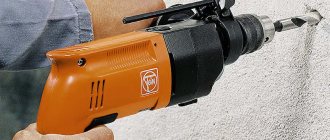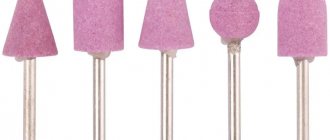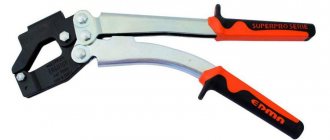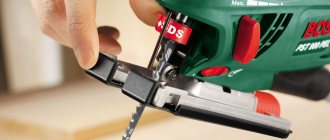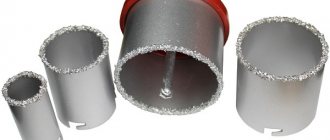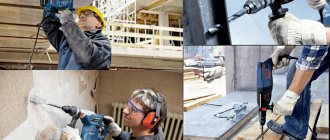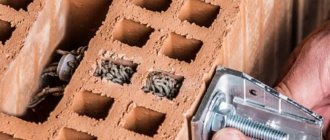It is a tool that is used for hand cutting wood in carpentry. Thanks to the unique shape of the device, it is possible to obtain diverse patterns and indentations of a certain shape on the tree. What exactly can be done with a chisel:
- Form a recess.
- Remove the chamfer.
- Make a carving.
- Make a groove.
- Chop off some of the excess wood.
The chisel consists of only two parts - the working part and the handle. The working part is a metal base of different diameters, shapes and types of sharpening. This is what is used when processing wooden bases. The handle can be plastic (cheap option) or wood (good option).
The sizes of chisels can be completely different. When choosing a tool, you need to consider what manipulations will be performed. The result of the work will depend on the type of cutting edge of the blade. Therefore, carpentry chisels are indispensable when making beautiful parts, figures or furniture from wood.
Types of wood chisels
Working with wood requires the presence of many diverse tools of the same group. Each chisel looks unique due to the structure of the working part and the structure of the metal blade. What types of chisels exist and are widely used in carpentry:
- Straight. This is a basic tool that is used to remove large layers of wood. As a result of the impact, the cells are obtained in the simplest form. This result is possible thanks to the wide blade of the working part of the device.
- An oblique chisel is a subtype of a straight chisel, but the functionality of such a working blade is slightly different. Used to form grooves with a longitudinal shape. You can also “cut down” excess material.
- Semicircular. A semicircular chisel with this sharpening is used in the first stages to form a wooden blank. Used to create complex patterns and ornaments. It has several types of cross-section: round, sloping and medium.
- Caesars. A subspecies of semicircular shaped device, in which the working part is 3 mm. With the help of caesars you can make grooves of shallow depth and a miniature pattern.
- Stichel. The cutter of such a tool is oblique on the working part, and the handle is shaped like a mushroom. This shape of the working part blade is ideal for cutting grooves. At the same time, the elements are accurate and neat.
- Klepik. It has a narrow working part, which is quite functional when making precise and miniature patterns or drawings on wood.
- Marigold. Often used by carpenters when forming patterns consisting of rounded parts and fragments. A small curved working part allows you to remove a minimum layer of wood.
Other types of tools presented can also be used in work, but more rarely. These are chisels of the cranberry type. A semicircular chisel for wood carving is used quite often by carpenters. Thanks to such devices with different base widths, it is possible to obtain diverse patterns and designs on wood, and to form the necessary elements and details.
Learning to work with a chisel correctly
Working with a chisel seems to be not an easy task and quite labor-intensive, which should be learned. For manipulation, force from hand pressure is used. But when there is little strength in the hands, and significant effort is required, in such cases it is appropriate to use a mallet. A mallet is a carpenter's hammer made from hard wood. A chisel paired with a mallet is used only during chiselling. For stripping and trimming procedures, it is permissible to use one chisel.
Before starting work, markings are applied with the device for the shape of the hole, socket or notch. The size of the tool is selected in accordance with the upcoming volume of work and the size of the slotting area. For ease of use, the slotting device is clamped in the left hand, and a mallet is taken in the right. Using a chisel, light taps are applied, which become more and more intensified as they go deeper into the thickness of the material.
Professional carpenters and carvers, as well as home wood craftsmen, always adhere to a certain pattern when working with a device. First of all, a pencil sketch is applied to the wooden blank - a drawing. After that, a recess is cut along the contour using the blade of a knife for wood carving. Only after clearly marking all the contour lines with a knife do they proceed to manipulation with a chisel.
Chisels with replaceable blades.
Methods of using the tool are determined taking into account what type of processing should be performed. As noted above, there are 2 most popular:
- Manual gain. For example, it is used when cutting the edges of a wooden part.
- Strengthening from the impact of another tool (hammer, mallet). It is sometimes required to obtain additional force in the process of gouging recesses or holes in wood.
When you can't do without a hammer
A device for sharpening chisels.
For the purpose of gouging and chopping, both chisels and mallets are used at the same time. For both procedures, the mallet is held in one hand and the chisel is positioned perpendicularly in the other hand. When you hit the chisel with a hammer, it rotates simultaneously. Thus ensuring that the end of the tool is always in the right place.
They produce special devices that are intended specifically for chiselling, their name is chisels. Manufacturing companies that have similar products are MATRIX and KIRSCHEN. The handles of such devices necessarily have shockproof properties and high strength, because they will often take a heavy load.
Unlike the gouging procedure, you may encounter some difficulties during the cutting process. Using a chisel it is possible to cut out, for example, recesses for door hinges. Any modern door between layers of wood has a layer of hardboard or MDF. Due to this, warping (change in shape) is avoided. But if the wood is not dried enough, even this measure will not save.
The loops will have to be slightly seated. To set the seating depth of the loops, the material is cut along the direction of the fibers by hitting the chisel with a hammer. Each specialist chooses the direction for cutting independently, focusing on personal convenience, from himself or to himself. The chisel is held as carefully and accurately as possible, so as not to spoil the material and not to injure yourself.
When they come closer to the marking, they try to make the chisel spring back after knocking. Why are hammer blows performed with a drawbar? When selecting wood at the edges of the markings, do not use a mallet; they work manually, adding a little more effort to remove excess material.
Important: when the wood has flaws (knotiness, curling - random arrangement of fibers), not very deep notches are made in such defective places.
Sharpening a chisel
One of the main parameters is the sharpening angle. For a chisel it is 20–35 degrees. The smaller the angle, the thinner the chips. For chisels used for cleaning edges, the angle is 20 degrees, for impact and selective ones - 25–30. For sharpening, a special machine and three types of whetstones are used, each subsequent one with a smaller abrasive grain. The ideal condition of the blade is razor sharp.
Depending on the intensity of work with the tool, you have to sharpen the chisel up to twice a year if the blade is made of good steel. In a home workshop, you need to sharpen a tool no more than once a year. When purchasing a tool, check the grade of steel it is made from. The best characteristics are for the brands HVG, 9ХС and 9ХФ, CrV; the blade may also be marked Drop Forged. If there are no inscriptions, then the quality of the material is questionable. Moreover, the information should not be written, but engraved. But for household use, you can also buy a tool with a painted inscription; as a rule, it is sold at a lower price than a professional one.
The size of the chisels is length from 125 to 280 mm with a blade width (depending on the type of blade) of 4–50 mm, weight from 100 to 400 grams. It is best to buy a medium-priced set of chisels, which should contain at least 5 tools. The problem with choosing a suitable chisel, in this case, for any job will automatically disappear.
Quality check
We determine the quality of a chisel by the duration of its service and the level of processing of the material. In fact, in addition to the handle, the main thing here is the hardness of the metal itself for the working part of the tool and its hardening.
The first step in choosing a good chisel is determining the appropriate type of steel.
The following types of materials are available on the market (sometimes only processing methods are indicated):
- forged
- drop forged; - CrV
– made from chrome vanadium - CS
– tool steel
We offer a way to determine the type of steel of a tool if for some reason it is not indicated on the chisel.
Try sharpening a chisel on a stone. The point is that on well-hardened steel, burrs appear from sharpening; they are then easy to remove. Steel that does not produce burrs is overheated and too hard. There is a possibility that the steel will split during operation. This may cause injury. And the third case - the steel produces burrs, but they cannot be removed. This indicates that the steel is too soft. When cutting into wood, steel will crumple.
Basic wood carving techniques with a chisel
Techniques for using a chisel are characterized by different positions of the device in relation to the wooden surface.
There are three main ways to work on wood with a chisel:
- Trimming - work is carried out along the side along the fibers; The tool is placed with the unsharpened side of the blade up, holding the handle with one hand and the blade with the other so that the thumb is pointed at the handle. Thanks to this method of holding the chisel, it is easier for the craftsman to set precise forces in order to ultimately obtain the most even and smooth surface of the wood product.
- Side cutting or groove cutting - chisels with a flat blade section are used to produce rectangular grooves. The sharp edge can be oblique or straight. Typically, such a model has a sharpened edge on only one side. Models with a semicircular sharp edge (in the form of a quarter or half a circle) of the blade are used for cutting grooves in a circular manner.
- Perpendicular cutting - the chisel is held by the handle with one hand, and the blade is held with the thumb and forefinger of the other hand. This method involves making single thin cuts of wood chips and will require the most effort compared to the others.
When working manually with this tool, it is better not to cut off a large layer of wood in one fell swoop, but to remove its excess gradually, adhering to the line planned in advance. Working on wood with a chisel requires precision and very precise distribution of effort - if you remove too much material, you will have to start all over again.
A distinction is made between manual strengthening and strengthening using an additional device - a mallet or hammer. They resort to percussion instruments made of wood or rubber in cases where they need to quickly make a depression or hole. But decorative parts with graceful contours require a lot of work and are cut out carefully, slowly, with a precisely calibrated calculation of each effort. After all, it is possible to make aesthetically pleasing and easy-to-use things from wood that will serve the owner for a long time and reliably.
Content:
- 1. Master's hands and direction of wood fibers
- 2. If you take a hammer to help
Professional carpenters and carvers, as well as those for whom working with wood is more of a hobby, use chisels according to the same pattern. First, a pencil drawing is applied to a wooden blank or part—drawing. Then the outline is deepened using a wood carving knife. Only after all the contours have been cut, are clearly visible and are not erased, do they begin to work with a chisel.
The method of using the tool is chosen depending on what kind of processing needs to be performed. There are two most common:
- Pressure by hand, when the tool is set in motion only by the force applied by a person, for example, as when trimming the edge of a piece of wood.
- With a mallet blow when additional force is needed to gouge grooves or holes in wood.
It is worth noting that for all its apparent simplicity, this is a rather complex and time-consuming matter. Largely because you need to use the tools very carefully and with extreme precision. After all, in some places you don’t put enough pressure on the chisel, and in others you squeeze it too hard, it’s very easy to ruin the part. One awkward hand movement or a not-so-successful blow with a mallet - and all the work will go down the drain. We'll have to start everything from scratch.
If you want to avoid such failures, we recommend reading this article. Here you will find some useful tips for working with chisels and mallets.
Universal chisel
Just a few years ago, work with wood was carried out using hand tools, but today there are devices, for example, an electric chisel, that make it possible to significantly facilitate the work of the master, as well as increase the speed of work while maintaining high quality.
An electric chisel is called universal because it allows you to carry out a wide range of work. High-power chisel models can cope with the removal of old parquet boards or rough processing of a large piece of wood, removing knots and other hard inclusions. It is impossible to cope with such work using only hand tools.
This tool is considered universal because it has many attachments of different shapes and sizes. For example, small semicircular and straight 4 mm bits will help you make patterned carvings or engrave the master’s initials, while more massive tools, up to 5 cm wide, are designed for removing wide chips and roughing.
From the history of terminology
The word "chisel" is borrowed from the German - Stemmeisen. The German word Stemmen translates to “chiseling, chiseling, gouging.” This term in German is used to refer specifically to a chisel, but a thin one, pushed forward by hand without using a mallet. To designate this particular type of cutters, it was borrowed by Russian craftsmen.
This term most likely came into use by craftsmen during the era of the reforms of Peter I. Interestingly, a chisel most often meant a flat hand tool, which today is called a chisel. Here is a fragment from A. A. Pchelnikov’s book “Conversations with Children” (1858): “With this flat one, which is called a chisel, sawn spikes or hollowed out holes, etc. are cut out and cleaned. With a semicircular chisel, semicircular recesses are removed and cleaned. Using slotting tetrahedral chisels, wide and narrow, they gouge out holes, take out grooves for inserting thin planks into frames, etc.” And in the Dictionary of Church Slavonic and Russian Languages (volume 4, 1847) a chisel is defined as “... a kind of chisel. Carpentry chisel, flat and tenon.” A more detailed definition is given by the authors of the Desktop Dictionary for reference in all branches of knowledge (volume 3, 1864): “A chisel, a carpentry tool, is used for gouging out holes and replacing a chisel. It is made of steel, 4 inches long, up to one inch wide” (1 inch = 4.45 cm).
It is not known exactly when the term “chisel” began to be used to refer to semicircular incisors. But in the publications we found before the end of the 19th century, this term is used specifically to designate a chisel, while the word “chisel” refers to cutters of various shapes, including semicircular ones. In the 30s of the XX century. Several editions have been published in which the chisel comes in different shapes, including a semicircular one. In the current linguistic tradition, including in the professional vocabulary of woodworking masters, a chisel is a common name for cutters of a similar design (most often semicircular), and a chisel is a straight cutter with a profile in the form of a hexagon or trapezoid, intended for creating grooves and splitting material and other operations.
Read about the types of chisel handles, recommendations for choosing chisels and other features of working with this type of hand tool in other specialized articles on our website.
Classifications of chisels
All types of chisels are divided into:
- carpentry;
- wood carvings;
- turning
Cutting pattern with a chisel: 1 – chips, 2 – workpiece, 3, 4 – cutters.
There is another division:
- according to the variant of movement in the thickness of the material;
- according to the shape of the handle;
- to size.
The basis for dividing instruments into groups is also taken as follows:
Operating principle of devices
The movement of the chisel in the thickness of the material occurs due to short taps on the handle with a special percussion instrument: a mallet or a hammer.
This type of hand tool is popular when processing hard woods that require tremendous physical force.
The devices are equipped with an elongated handle and a cutting element. Using a chisel, hold it in your hand, and with the other you perform monotonous taps on the handle. The handle structure is strengthened by a loop. For greater effectiveness of the procedures, use a hammer made of rubber or polyurethane.
Another type of chisel is with a long handle, but a shortened cutter. Their purpose is for manipulation with both hands when moving the instrument.
Chisels (a), flat (b) and semicircular (c) chisels: 1 – blade, 2 – cap, 3 – handle, 4 – ring.
Work with such devices is carried out on soft types of wood. The smooth head of the rounded handle fits comfortably in your fist. It is possible to use a rubber hammer when the density of the wood is high and it is necessary to improve movement in the thickness of the rock.
Security measures
Bearing in mind that this device is equipped with an electronic drive, any home craftsman must follow the safety rules while working. One of them says that it is not allowed to start working with an electric chisel without working gloves and glasses.
Preparing for work
It is also important to properly prepare the tool for work - to do this, it must be firmly fixed in a special socket, and to carry out this activity correctly, you must adhere to the following method:
- First you need to unlock the socket using a special locking switch located on the body of the tool.
- After unlocking, the working tool itself is placed in the socket, and this is done in such a way that its cutting edge is oriented downward.
- When the tool is installed, the socket will be blocked by pushing the locking switch forward.
After each work and removing the device from the socket, you need to carefully clean the electric scraper itself, as well as its rod.
The all-purpose chisel is turned on using a special toggle switch located on the body of the tool . It is also used to turn off the device. To set the required processing speed, you must first disable the tool, and then you can create its settings. This is done using a special switch located on the device body. All models of chisels equipped with an electronic drive allow you to set one of 3 high-speed modes:
- low moving speed. Selected when the highest processing accuracy is required to effectively complete a task.
- Average speed.
- Highest speed. It is used when it is important to perform a certain operation very quickly.
Manufacturers do not give specific instructions on choosing a more suitable speed of movement of the working tool . This must be created by the master himself at his own discretion, also taking into account the characteristics of the surface being processed.
Mechanism of operation
The work process itself with the introduction of an electric chisel should follow the following method:
- After switching on, the tool is moved to the surface being processed and positioned at a slight angle to it.
- Applying slight pressure with the implement on the surface to be treated, it is carried along it in the direction “away from you”.
- During processing, it is important to correctly select the force exerted by the equipment on the surface being processed, which does not have to be very enormous. Otherwise, the tool will quickly break.
Almost all models of electric chisels displayed in stores are intended for use in household conditions, so you should not work with them for a very long time in continuous mode and subject them to excessive overloads , due to which the tool can quickly fail. To extend the service life of the electric scraper, you need to avoid heavy loads, and after each working cycle, take a pause so that the device can cool down. Effective work with inventory is only possible if the working tool with which the products are processed is constantly sharpened accordingly.
How to do it yourself
Using available tools, you can make a chisel yourself. In some cases, it is enough to slightly correct the shape and sharpen it, while in others you will have to resort to forging.
Chisel from a milling cutter
Often, a milling cutter is used as a base material for making chisels yourself. The metal of this part is quite durable. It is easy to give it the desired shape. Manufacturing principle:
- Cut out a piece of metal of the required size from the cutter.
- The surface of the workpiece is carefully polished. The workpiece is given the desired shape.
- The next step will be making the handle from wood.
At the end, all the constituent elements are assembled. Usually the handle is made of 2 parts, which are connected by pins.
Metal drill tool
You can make an angular version of the working blade from a drill. How to make a tool from such a base:
- Select a drill with a suitable diameter. Flatten the tip to form the desired thickness and width.
- Using grinding, you can give the knife part the desired shape. A drill can be an excellent base for creating a “nail”.
- The final stage of manufacturing will be the handle. You need to prepare two halves of wood and twist them with a pin.
If you use a drill as a base, you can get a working part of any parameter.
Semicircular chisels
A semicircular chisel for wood carving can be made from a punch that has a similar shape. Algorithm for making a semicircular chisel from a punch:
- Prepare a punch of approximate size.
- Using a grinder, remove the excess part of the radial part.
- While the metal has not cooled down after cutting, you need to immediately sharpen the edges.
- The last step is to sharpen the blade using a grinder.
The tool is ready to use.
We use a file
A file can be an excellent base for making a straight chisel. The working tool is a grinding wheel. But first you need to choose the right file. Take into account the desired parameters of the future device, the type of metal and the grain size of the file.
Using a grinding wheel, all excess is cut off and the desired shape is formed. The next stage will be sharpening and shaping the handle. It is the handle that deserves special attention. Often a standard file tip is used as a base, but it is not suitable for a chisel. You need to flatten the narrow part and only then attach the wooden base.
If you cut the cutters correctly and then perform high-quality sharpening, then you can also get a corner chisel from a file. In this case, you will have to put in more effort.
Files
A needle file is also a good basis for forming homemade woodworking equipment. Manufacturing and processing features:
- The file needs to be heated strongly and evenly. This is necessary in order to perform actions similar to forging.
- After heating, bend the base until the desired shape is obtained.
- The finished workpiece must be immersed in water. This will cool the metal and harden it.
Sharpening the “blade” and attaching the handle will be the final stage in creating the equipment.
Angle chisels
Angle chisels can be obtained from profile tools by heating metal. After heating the workpiece, it is given the desired shape. Then the handle is hardened, sharpened and secured.
A chisel is the main tool in working with wood if you need to create a beautiful pattern, remove excess wood or form a groove. There are many types of this tool, each of which has its own intended use. You can make the device yourself if you use available materials.
Working on a lathe
Nowadays, wood lathes are often used to produce functional parts for furniture. In addition, this machine will help you make cute and unusual decorative elements, for example, candelabra, cups, toys, tops and more.
Lathes come in different sizes. Before all this, you need to choose the most suitable machine. These days, there is a fairly wide range of tabletop lathes that are perfectly suitable for a small project. The largest devices are used to create balusters, which are used for the production of furniture and railings.
Characteristics by which lathes differ:
- bed length. It describes the longest length of the processed bar
- the diameter of the turning above the bed is the largest diameter of the bar
- horsepower - the power of the unit, which determines the mass of the block for turning without overloading the cutter and the machine
- engine revolutions per minute. Most machines have a constant speed. Devices with a low high-speed mode can be used to process workpieces of irregular shape. And the highest speeds help polish the product.
When purchasing, pay attention to the weight and material from which the machine is made. Options with a cast iron bed and iron frame are quite strong, but not mobile. They cannot be rearranged to another work space.
Turning cutters are distinguished by a long, curved handle. It is designed to make it comfortable for the master to hold the tool. As a result of having such a handle, the master carefully controls the blade, but at the same time does not feel tired. Cutters for manual processing are not suitable for working on a machine, because they have a small handle.
Carver's workplace
Wood carving involves working with sharp objects, so it must be done at a workbench that meets the necessary requirements for stability and strength. If you don't have a workbench, you can use a tabletop of any size. At the same time, its height should not exceed the level of the carver’s belt. During operation, nicks often form and must be removed. The board on which the ornament is cut must be firmly secured with clamps.
Lighting is also important. For a lot of natural light, the table should be placed near a window. When there is only one light source, dull dark shadows are observed, making it difficult to make a clean carving. Professionals advise installing 2-3 more lamps above the table. They need to be installed in such a way that they illuminate the table from different sides. Light sources should be located above the carver's eyes. Comfort and safety are the result of high-quality lighting.
Caring for whetstones
Store sharpening stones so that dust does not collect on their surface. When using a whetstone, the surface eventually becomes clogged, clogged with a mixture of oil and metal dust. As soon as it stops sharpening normally, rub it with paraffin and treat it with coarse burlap.
Impregnation of stones with water wetting
Before using such a stone, it should be soaked in water by immersion. A coarse-grained stone will need 4 to 5 minutes to saturate, and a hard, fine-grained stone will need a little less. Store such stones in special vinyl boxes so that moisture does not evaporate from it and it is always ready for use. Another storage method is to keep the stone in water. Under no circumstances should such a stone be allowed to freeze—it will almost certainly crack.
Restoring whetstones
After a certain period of work, a groove appears on the grindstone - a depression from which its particles have been erased. Level oil-wet stones by grinding with carborundum powder mixed with water or oil on the glass. The surface of water-wet stone can be restored by sanding with 200-grit silicon carbide sandpaper attached to the glass.
Leveling the surface of the whetstone
